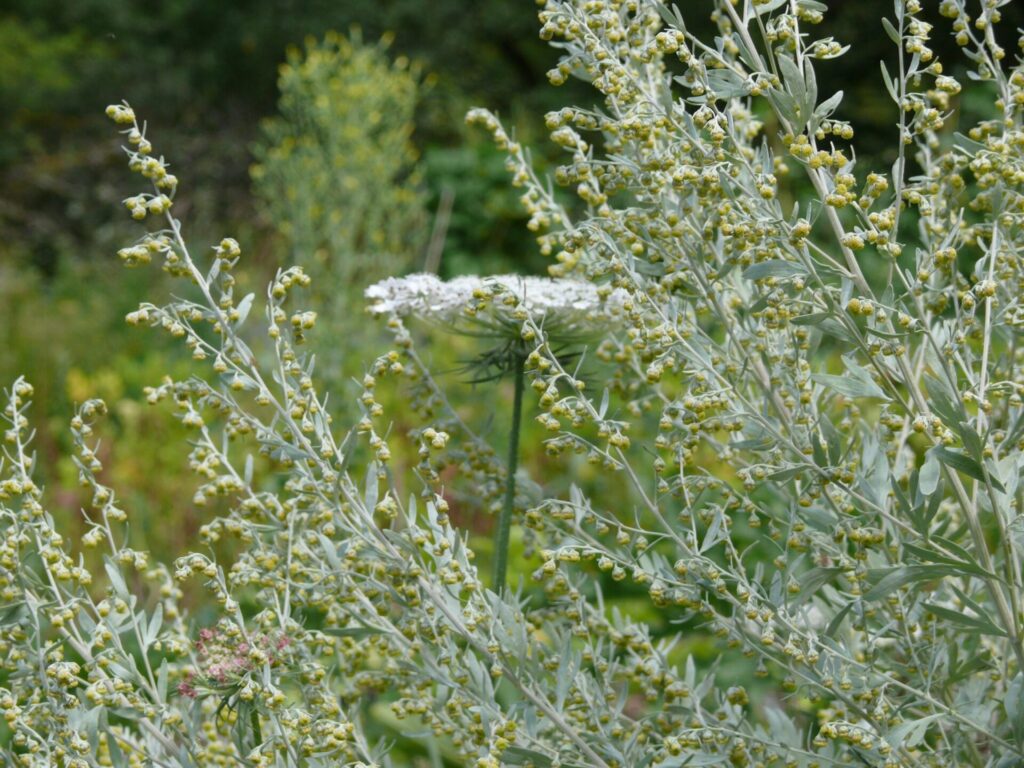Wormwood
Artemisia absinthium L.
Compositae
Wormwood is an aromatic, bushy, evergreen perennial with finely delineated leaves that are grey-green on top and silver underneath. In summer, it offers panicles composed of bunches of small yellow flowers.
The name of the species, absinthium , is derived from the Greek, , which means “lacking sweetness,” referring to the plant’s characteristic bitterness. Wormwood is mentioned in the English translation of the Book of Revelation: “ The third angel sounded his trumpet, and a great star, blazing like a torch, fell from the sky on a third of the rivers and on the springs of water— 11 the name of the star is Wormwood.[a] A third of the waters turned bitter, and many people died from the waters that had become bitter.”(Revelation 8, 10-12).
Wormwood is a medicinal plant used since antiquity as a digestive, tonic, and anti-parasitic, but history remembers it most for its use in the liquor known as absinthe. Its moment of glory (followed by disgrace) happened between the nineteenth and twentieth centuries.
Absinthe as we know it seems to have appeared in Switzerland around 1750 as a medicinal elixir. This concoction was nicknamed “the green fairy” for its green color and supposed “magical” properties.
The drink gained in popularity over time, and around 1830 it became quite fashionable. French soldiers on colonial campaigns were persuaded of its curing powers, putting a few drops in their water to fight off fever and dysentery. They developed a taste for absinthe and continued this habit upon their return to France. They were imitated first by the bourgeoisie, who admired them as conquerors, and then by artists in search of new pleasures. Vincent van Gogh, Henri de Toulouse-Lautrec, Verlaine, Rimbaud, Baudelaire, and many others gave absinthe a place of honor in their masterpieces.
Formerly expensive and reserved for the elite, absinthe was democratized around 1870. It became a better deal than the wine with which it had begun to compete. Consumption rose sharply in France from 7 000 hectoliters in 1874 to 360 000 hectoliters in 1910, a year in which we estimate that 90% of the country’s population drank absinthe.
In the bistros, “green hour” started at around 6pm with the ritual of absinthe tasting. One placed a lump of sugar on a perforated spoon resting on the lip of a glass containing absinthe. Then ice-cold water was poured very slowly over the sugar, which dissolved little by little, falling drop by drop, agitating the green liquid that became an opalescent white.
This conversation-promoting mode of preparation is part of the reason for the infatuation with absinthe. But its success was followed by a horrible reputation that made it a synonym of alcoholism and madness. The excessive consumption of absinthe provoked hallucinations and shaking – symptoms that were described as a new illness: “absinthism.” We attribute this to an essential oil contained in the plant that is rich in thujone, a poison which affects the nervous system.
The price of absinthe was often lowered by using adulterated alcohols or adding essential oils or copper salts to give it color … falsities that exacerbated the plant’s nefarious effects.
In 1906, temperance movement activists joined with (surprisingly) wine-makers under the slogan “all for wine, against absinthe!” A petition was created demanding the illegalization of absinthe and denouncing its supposed dangers: “Absinthe turns you mad and delinquent… it makes a man into a ferocious beast, a woman into a martyr, a child into a degenerate. It tears families apart and is thus a threat to the future of the country…”
The ban was finally voted into place in 1915 after the first skirmish with Germany.
Today, it is clear that the symptoms of “absinthism” were essentially the product of alcoholism and the dangerous chemical additives used in low-quality absinthes.
It wasn’t until 2001 that the commercialization of absinthe was reauthorized in France with a maximum thujone limit of 35mg/l.
In 2011, the word “absinthe” was reauthorized for labelling, and absinthe was revived.
The Green Fairy
Wine gives everything a new coat – even the most sordid
Moves with miraculous luxury,
It brings out more than one fabulous balcony
In the gold of its red steam,
Like a setting sun in a nebulous sky.
Opium expands what has no limits,
Extends the unlimited,
Deepens time, deepens voluptuousness,
And black and dull pleasures
Remplit l’âme au-delà de sa capacité.
None of this is worth as much as the poison that comes from
Your eyes, your green eyes,
Lakes where my soul trembles and sees itself upside down…
My dreams come in crowds
To quench their thirst at these bitter abysses.
None of this worth a much as the terrible prodigy
Your biting saliva,
Who plunges my soul into oblivion without remorse,
And, laden with vertigo,
The failing roll to the banks of death
Charles Baudelaire
